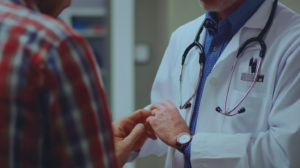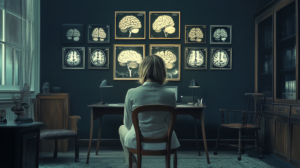
Present Perfect Continuous 4
English Blogs “Let’s Learn, Explore, and Connect to the World” Present Perfect Continuous 4 IV. Forming Questions and Negatives in the Present Perfect Continuous Mastering



 Many people think of soldiers when they hear about PTSD, but it can actually affect anyone. Scary and dangerous situations, like a horrible accident, a terrible natural disaster, or a violent crime, can trigger PTSD. The disorder can profoundly impact an individual’s daily life, influencing their emotional state, relationships, and overall ability to function.
Many people think of soldiers when they hear about PTSD, but it can actually affect anyone. Scary and dangerous situations, like a horrible accident, a terrible natural disaster, or a violent crime, can trigger PTSD. The disorder can profoundly impact an individual’s daily life, influencing their emotional state, relationships, and overall ability to function.
Despite its significant presence in our society, PTSD is frequently misunderstood, and many myths surround its causes and manifestations. Because many people don’t fully understand PTSD, those struggling with it might face negative judgment, lack of help, and trouble getting the treatment they need. That’s why learning about PTSD is important, not just for the people with it, but also for the people who care about them.
This blog post aims to demystify PTSD by exploring its causes, symptoms, and the healing processes available. By providing a deeper insight into the disorder, we hope to foster empathy, improve awareness, and offer helpful information for those looking to support themselves or someone they know in managing the challenges that come with PTSD.
Someone can develop PTSD after a very scary or dangerous event, like a bad accident, a natural disaster, or a violent attack. This mental health problem can make it hard for them to think clearly, manage their emotions, and function in daily life.

While PTSD was first recognized in war veterans, it can actually happen to anyone after a scary experience. To be officially diagnosed, the problems have to last for more than a month and cause significant difficulties in someone’s relationships or job. The diagnosis itself is complex and can only be made by a trained specialist through an assessment that involves discussing the individual’s symptoms and the traumatic events they have experienced.

The understanding of PTSD has evolved over the years. It was once considered a condition only affecting war veterans—historically called “shell shock” and later “combat fatigue.” With broader research and observation, the medical community recognized that PTSD could result from a variety of traumatic experiences, not just war. Today, it’s recognized globally as a condition that requires understanding, medical treatment, and societal compassion.

While PTSD is a type of anxiety disorder, it is distinct because it is specifically tied to experiencing or witnessing traumatic events. Unlike generalized anxiety disorder, which can develop without any identifiable triggering event, PTSD always involves a triggering event. Furthermore, PTSD encompasses a range of symptoms that are categorized into four main groups:
1. Re-experiencing: This includes flashbacks, nightmares, and intense, involuntary memories of the event.
2. Avoidance: Individuals may avoid places, activities, or people that remind them of the traumatic event.
3. Problems with how you think and feel: This can manifest as distorted feelings like guilt or blame, ongoing fear, horror, alienation from others, or a diminished ability to experience positive emotions.
4. Alterations in arousal and reactivity: This is characterized by being overly alert or wound up, having difficulty sleeping, being irritable, and having angry outbursts or behaving recklessly.
Understanding PTSD not only involves recognizing the symptoms and triggers but also comprehending its profound impact on an individual’s life. Understanding PTSD is key to getting the right treatment and building a supportive network that helps people heal and move forward.
People can develop PTSD after a scary or dangerous event that makes them feel unsafe. To help prevent and treat it, we need to understand what causes it. Let’s explore the main reasons people get PTSD and what makes them more likely to experience it. Here’s a closer look at the primary causes and risk factors associated with PTSD:

1. Types of Traumatic Events: The events that can lead to PTSD are diverse and include:
All these events can cause strong feelings of fear, helplessness, and terror. These feelings are a big part of why someone might develop PTSD.

2. Psychological Factors: Individual psychological factors play a significant role in whether a person exposed to trauma develops PTSD. These factors include:

3. Biological Factors: Even things like a person’s genes or brain functions can affect their risk of developing PTSD. Studies suggest that:

4. Environmental Factors: Environmental influences before, during, or after the traumatic event can also impact the likelihood of developing PTSD. These include:

5. Duration and Intensity of Trauma: The risk of developing PTSD increases with the duration and severity of the trauma. Prolonged exposure to a stressful environment or repeated traumatic events (as often seen in military combat) can compound the effects of the initial trauma and increase the likelihood of PTSD.
Knowing the causes and risk factors is vital so we can spot people more likely to get PTSD and get them help early on. Recognizing the complexity of these factors also highlights the importance of comprehensive approaches in treatment, which address not only the psychological effects of trauma but also the biological and social dimensions of recovery.
 Post-Traumatic Stress Disorder (PTSD) manifests through a complex array of symptoms that can significantly impair an individual’s daily functioning and quality of life. People with PTSD experience symptoms in four main ways: reliving the event, avoiding reminders, negative thoughts and feelings, and feeling jumpy or on edge. Recognizing these signs early is key to getting effective treatment for PTSD.
Post-Traumatic Stress Disorder (PTSD) manifests through a complex array of symptoms that can significantly impair an individual’s daily functioning and quality of life. People with PTSD experience symptoms in four main ways: reliving the event, avoiding reminders, negative thoughts and feelings, and feeling jumpy or on edge. Recognizing these signs early is key to getting effective treatment for PTSD.

These symptoms can be triggered by words, situations, or environmental cues that recall the trauma, making them particularly difficult to predict and manage.

Such avoidance can lead to isolation and withdrawal from social activities, which can exacerbate other symptoms of PTSD.

These symptoms can significantly impair interpersonal relationships and lead to a pervasive sense of hopelessness or depression.

These arousal symptoms can be particularly challenging as they often lead to increased stress and difficulty managing daily tasks and responsibilities.
The breadth and intensity of PTSD symptoms can vary greatly among individuals, influenced by the nature of the trauma, personal history, and available support systems. Knowing these signs is the first step to getting help. With treatment, people can develop a plan that works best for them to recover from PTSD.
The consequences of Post-Traumatic Stress Disorder (PTSD) extend far beyond the individual symptoms experienced by those affected. PTSD can profoundly impact nearly every aspect of an individual’s life, including their personal relationships, professional performance, and overall physical health. Understanding these impacts can help recognize the seriousness of the disorder and the critical need for effective treatment and support.

1. Personal and Social Relationships: PTSD can severely strain relationships with family, friends, and colleagues. Symptoms like irritability, mood swings, and withdrawal can make sufferers seem distant or aggressive, making it difficult for loved ones to maintain normal interactions. The avoidance symptoms of PTSD may lead individuals to skip social gatherings, isolate themselves, and reduce their engagement in once-cherished activities, further distancing themselves from social support networks that are crucial for recovery.

2. Professional Life: In the workplace, PTSD can manifest as difficulties in concentration, memory lapses, and a lack of interest in the job, all of which can impair productivity and performance. The heightened arousal symptoms of PTSD, such as irritability and an exaggerated startle response, can make normal work interactions challenging and stressful. This often leads to job instability and can even result in unemployment, exacerbating the financial and mental strain on the individual.

3. Physical Health: The constant stress and anxiety of PTSD can hurt not just your mind, but your body too. People with PTSD are more likely to get health problems like heart disease, diabetes, and stomach issues. This can happen because of the stress itself, or because they might have trouble eating healthy or taking care of themselves when they’re struggling with PTSD symptoms. Additionally, the constant state of high alert and tension can lead to chronic exhaustion and somatic symptoms like headaches and muscle pain.

4. Mental Health Complications: People with PTSD often experience other mental health problems too, like depression, anxiety, or even using drugs or alcohol to cope. The overwhelming nature of PTSD symptoms can drive individuals to seek relief from alcohol or drugs, which can spiral into substance dependency. Furthermore, the persistent feeling of hopelessness, guilt, or shame can increase the risk of severe depression and anxiety, compounding the challenges of treatment and recovery.

5. Community and Economic Impact: On a larger scale, the collective impact of PTSD on communities and the economy is substantial. The healthcare costs associated with treating PTSD and its comorbidities, the loss of productivity in the workplace, and the social costs of increased homelessness and family breakdown contribute to the economic burden. Communities with high levels of trauma exposure (such as those affected by violence, natural disasters, or military conflict) require significant resources to manage the cumulative mental health repercussions.
Because PTSD can affect so many parts of life, it’s not just a personal problem, it’s a wider issue for society. That’s why it’s important to find ways to help people with PTSD. Effective intervention strategies, timely access to mental health services, and community support systems are essential in mitigating the impact of PTSD and supporting those affected toward recovery and well-being.
 The treatment and healing journey for those suffering from Post-Traumatic Stress Disorder (PTSD) is often multifaceted, involving various strategies and approaches to manage symptoms and facilitate recovery. Effective treatment plans are typically personalized, taking into account the individual’s specific symptoms, experiences, and needs. Here’s a detailed look at the most effective treatment options and healing approaches for PTSD:
The treatment and healing journey for those suffering from Post-Traumatic Stress Disorder (PTSD) is often multifaceted, involving various strategies and approaches to manage symptoms and facilitate recovery. Effective treatment plans are typically personalized, taking into account the individual’s specific symptoms, experiences, and needs. Here’s a detailed look at the most effective treatment options and healing approaches for PTSD:



 4. Support Systems: Building a strong support network is crucial for recovery. Support can come from family, friends, support groups, or community organizations. Engaging with others who understand PTSD can provide emotional comfort and practical advice for managing symptoms.
4. Support Systems: Building a strong support network is crucial for recovery. Support can come from family, friends, support groups, or community organizations. Engaging with others who understand PTSD can provide emotional comfort and practical advice for managing symptoms.
5.  Holistic Approaches: Lifestyle changes can also play a supportive role in managing PTSD. Think of healthy habits like sleep, exercise, good food, and staying away from alcohol and drugs as superpowers for people with PTSD. These can make them feel stronger overall and help other treatments work even better.
Holistic Approaches: Lifestyle changes can also play a supportive role in managing PTSD. Think of healthy habits like sleep, exercise, good food, and staying away from alcohol and drugs as superpowers for people with PTSD. These can make them feel stronger overall and help other treatments work even better.
The path to healing from PTSD is a process that requires time, patience, and often a combination of different therapies and supports. With the right treatment plan and support network, individuals with PTSD can achieve significant improvements in their symptoms and quality of life, eventually leading to recovery.
Preventing PTSD and ensuring early intervention when trauma occurs are crucial steps in mitigating the long-term impact of traumatic events. While not all instances of trauma can be prevented, especially those involving natural disasters or unexpected accidents, there are strategies that can reduce the likelihood of developing PTSD and aid in early recovery.

1. Education and Awareness: Educating individuals and communities about the signs and symptoms of PTSD is vital. Awareness can empower those affected by trauma to seek help early and encourage communities to support vulnerable individuals proactively.

2. Immediate Support: Immediate post-trauma support, sometimes called psychological first aid, can be crucial in preventing PTSD. This support involves providing a safe environment, ensuring the basic needs of the trauma survivors are met, and offering compassionate and non-judgmental assistance. Early intervention can also include debriefing sessions where individuals can discuss their experiences in a supportive setting.

3. Strengthening Resilience: Building resilience before trauma occurs can also be an effective preventive measure. This can involve training in coping strategies, stress management techniques, and building strong social support networks. People who are good at bouncing back from tough times are more likely to cope with a scary event and less likely to get PTSD.

4. Professional Mental Health Support: Encouraging those who have experienced trauma to seek professional mental health support can significantly aid in preventing PTSD. Early therapeutic intervention can address symptoms before they become severe and help individuals process the trauma in healthy ways.
By prioritizing prevention and early intervention, it is possible to reduce the prevalence and severity of PTSD among those exposed to trauma. These coping mechanisms aren’t just helpful right after a traumatic event, they can also help people stay mentally healthy in the long run. Learning these coping skills helps people and communities build their inner strength, so they can face challenges head-on.
 Understanding PTSD is essential for providing support to those affected and for fostering resilient communities. By recognizing the causes, symptoms, and effective treatments, we can better assist individuals in navigating their healing journeys. This guide underscores the importance of early intervention, tailored treatment plans, and ongoing support to manage PTSD. Awareness and education are key to reducing stigma and promoting timely and effective care. As we continue to learn more about PTSD, it’s crucial that we remain committed to advancing treatment approaches and support systems, ensuring that every individual has the opportunity to recover and thrive after experiencing trauma.
Understanding PTSD is essential for providing support to those affected and for fostering resilient communities. By recognizing the causes, symptoms, and effective treatments, we can better assist individuals in navigating their healing journeys. This guide underscores the importance of early intervention, tailored treatment plans, and ongoing support to manage PTSD. Awareness and education are key to reducing stigma and promoting timely and effective care. As we continue to learn more about PTSD, it’s crucial that we remain committed to advancing treatment approaches and support systems, ensuring that every individual has the opportunity to recover and thrive after experiencing trauma.

English Blogs “Let’s Learn, Explore, and Connect to the World” Present Perfect Continuous 4 IV. Forming Questions and Negatives in the Present Perfect Continuous Mastering

Explore the world confidently with ‘Travel English’ by Allison Kate, a comic-style guide full of essential conversations and tips for every traveler. Speak English with ease in airports, hotels, and more!



